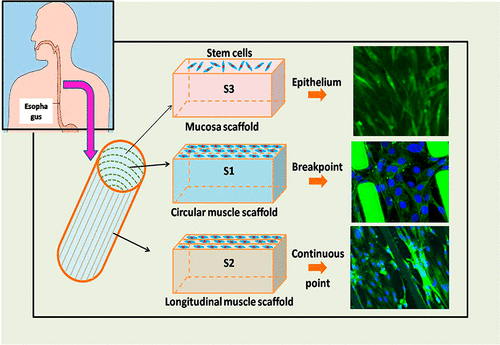当前位置:
X-MOL 学术
›
ACS Appl. Bio Mater.
›
论文详情
Our official English website, www.x-mol.net, welcomes your
feedback! (Note: you will need to create a separate account there.)
Differentiation of bMSCs on Biocompatible, Biodegradable, and Biomimetic Scaffolds for Largely Defected Tissue Repair
ACS Applied Bio Materials ( IF 4.6 ) Pub Date : 2020-01-07 , DOI: 10.1021/acsabm.9b01063 Xingyuan Wang 1 , Jiachang Jin 1 , Ruixia Hou 1, 2 , Mi Zhou 1 , Xianbo Mou 1 , Kui Xu 1 , Yabin Zhu 1 , Zhisen Shen 3 , Xingcai Zhang 4
ACS Applied Bio Materials ( IF 4.6 ) Pub Date : 2020-01-07 , DOI: 10.1021/acsabm.9b01063 Xingyuan Wang 1 , Jiachang Jin 1 , Ruixia Hou 1, 2 , Mi Zhou 1 , Xianbo Mou 1 , Kui Xu 1 , Yabin Zhu 1 , Zhisen Shen 3 , Xingcai Zhang 4
Affiliation

|
Biocompatible, biodegradable, and biomimetic scaffolds in combination with stem cells are of great importance for tissue engineering, especially the repairing and regeneration of defected organs. As a case in point, esophageal diseases have become serious clinical problems because of the poor self-repairing ability of the organ. It is crucial to prepare artificial replacements with biological function for serious lesions of the esophagus. However, the pH value, mechanical strength, thickness, and other physical conditions are very different in different organs or different parts of the same organ, which pose high difficulty for successful tissue engineering. In this work, bone marrow mesenchymal stem cells (bMSCs) were isolated from rabbits and transfected with green fluorescent protein (GFP) to follow their capabilities of growth, stemness, and differentiation in ex vivo culture. These bMSCs were seeded on biocompatible, biodegradable, and biomimetic scaffolds to detect the tissue regenerative capability of the esophagus with multilayer hierarchical structure. According to the esophageal bilayer muscle architecture, we designed discontinuous and continuous microchannel patterned scaffolds with medical level polyurethane (PU) as the matrix to guide the inner-circular and outer-longitudinal muscle growth. The gap on the discontinuous walls not only helped cells to communicate with each other but also assisted cells to infiltrate through the gap and grew into the inner circular muscle. The graft of silk fibroin on the scaffold surface using the aminolysis and glutaraldehyde cross-linking method enhanced the substrate’s hydrophilicity and biocompatibility. Mucosa-submucosa tissue of rabbit’s esophagus was decellularized to obtain the extracellular matrix (ECM) and implanted in situ after recellularizing with bMSCs to repair the partially defected rabbits’ esophagus. On the basis of both in vitro and in vivo results, we concluded that esophagus regeneration was promoted by the differentiation of bMSCs on the biocompatible, biodegradable, and biomimetic scaffolds, starting from tissue “niches”, to repair the largely defected esophagus, which paves the way for tissue engineering and defected organ treatments.
中文翻译:

bMSCs 在生物相容性、可生物降解和仿生支架上的分化用于严重缺陷组织修复
与干细胞相结合的生物相容性、可生物降解和仿生支架对于组织工程,尤其是缺陷器官的修复和再生具有重要意义。例如,食管疾病由于器官的自我修复能力差,已成为严重的临床问题。对于食管的严重病变,制备具有生物学功能的人工替代物至关重要。然而,不同器官或同一器官不同部位的pH值、机械强度、厚度等物理条件存在很大差异,这给组织工程的成功带来了很大的困难。在这项工作中,从兔子身上分离出骨髓间充质干细胞(bMSCs)并用绿色荧光蛋白(GFP)转染,以追踪它们的生长能力、干性、和离体培养中的分化。将这些 bMSCs 接种在生物相容、可生物降解和仿生支架上,以检测具有多层层次结构的食管组织再生能力。根据食管双层肌肉结构,我们设计了以医用级聚氨酯(PU)为基质的不连续和连续的微通道图案化支架,以引导内环和外纵肌生长。不连续壁上的缝隙不仅有助于细胞相互交流,还有助于细胞通过缝隙浸润并生长到内环肌中。采用氨解和戊二醛交联法在支架表面接枝丝素蛋白,增强了基材的亲水性和生物相容性。将兔食管黏膜-黏膜下层组织脱细胞,获得细胞外基质(ECM),用骨髓间充质干细胞再细胞化后原位植入,修复部分缺损的家兔食管。在两者的基础上在体外和体内结果中,我们得出结论,bMSCs 在生物相容性、可生物降解和仿生支架上的分化促进了食道再生,从组织“生态位”开始,修复大部分缺陷的食道,这为组织工程铺平了道路和有缺陷的器官治疗。
更新日期:2020-01-07
中文翻译:

bMSCs 在生物相容性、可生物降解和仿生支架上的分化用于严重缺陷组织修复
与干细胞相结合的生物相容性、可生物降解和仿生支架对于组织工程,尤其是缺陷器官的修复和再生具有重要意义。例如,食管疾病由于器官的自我修复能力差,已成为严重的临床问题。对于食管的严重病变,制备具有生物学功能的人工替代物至关重要。然而,不同器官或同一器官不同部位的pH值、机械强度、厚度等物理条件存在很大差异,这给组织工程的成功带来了很大的困难。在这项工作中,从兔子身上分离出骨髓间充质干细胞(bMSCs)并用绿色荧光蛋白(GFP)转染,以追踪它们的生长能力、干性、和离体培养中的分化。将这些 bMSCs 接种在生物相容、可生物降解和仿生支架上,以检测具有多层层次结构的食管组织再生能力。根据食管双层肌肉结构,我们设计了以医用级聚氨酯(PU)为基质的不连续和连续的微通道图案化支架,以引导内环和外纵肌生长。不连续壁上的缝隙不仅有助于细胞相互交流,还有助于细胞通过缝隙浸润并生长到内环肌中。采用氨解和戊二醛交联法在支架表面接枝丝素蛋白,增强了基材的亲水性和生物相容性。将兔食管黏膜-黏膜下层组织脱细胞,获得细胞外基质(ECM),用骨髓间充质干细胞再细胞化后原位植入,修复部分缺损的家兔食管。在两者的基础上在体外和体内结果中,我们得出结论,bMSCs 在生物相容性、可生物降解和仿生支架上的分化促进了食道再生,从组织“生态位”开始,修复大部分缺陷的食道,这为组织工程铺平了道路和有缺陷的器官治疗。











































 京公网安备 11010802027423号
京公网安备 11010802027423号